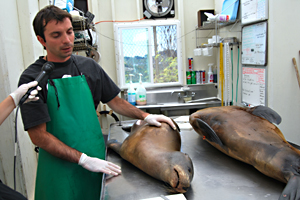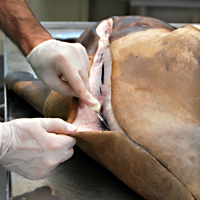
For these notes, I thought I'd focus on something that didn’t make it into the sea lions radio broadcast: the necropsy.
Each year the Marine Mammal Center treats somewhere between 600-1000 animals, including California sea lions, Pacific harbor seals, Northern elephant seals, and steller sea lions. About half of them are treated successfully at the center and released into the Pacific. The other half either die naturally or have to be euthanized.
Most of them end up at the center's hospital after passersby spot the animals on the beach and sense something’s wrong. (The Marine Mammal center responds to calls anywhere between Mendocino and San Louis Obispo Counties -- some 600 miles of coastline.) Some problems are human-caused, like boat-propeller injuries or ingested fishing nets and hooks. Other times, it's cancer, domoic acid poisoning, or leptospirosis. Sometimes, it's hard to tell exactly what happened -- hence the need for necropsies.
On the day that Quest intern Jennifer Skene and I visited the center, veterinarian Nicola Pussini performed two necropsies, both on sea lions. One animal seemed to have died from a tumor underneath his fin; the other was a suspected domoic acid intoxication.
 Each necropsy takes about an hour and a half. First Pussini measures the animal, then he slices it open and inspects every part, from tongue to tail. He inspects the teeth, pulls out all the organs, checks to see how much fat the animal has. The data, along with tissue samples, are archived and shared with other research institutions. This is the kind of basic research that Marine Mammal Center staff cite when people ask why they devote so many resources (most of it from private donations) to animals whose populations are neither threatened nor endangered.
Each necropsy takes about an hour and a half. First Pussini measures the animal, then he slices it open and inspects every part, from tongue to tail. He inspects the teeth, pulls out all the organs, checks to see how much fat the animal has. The data, along with tissue samples, are archived and shared with other research institutions. This is the kind of basic research that Marine Mammal Center staff cite when people ask why they devote so many resources (most of it from private donations) to animals whose populations are neither threatened nor endangered.
